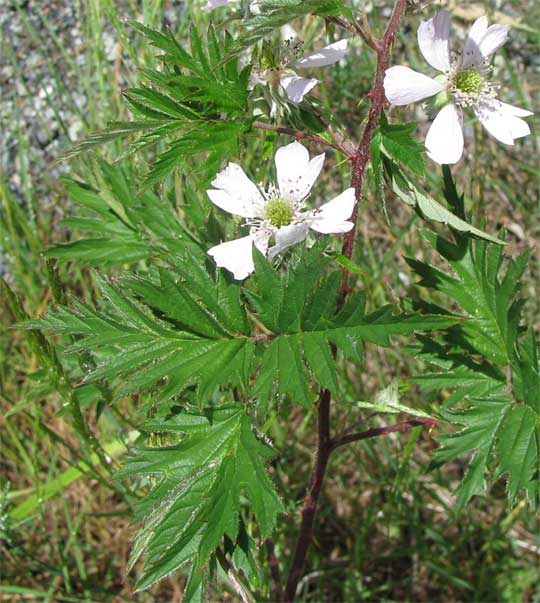Excerpts from Jim Conrad's
Naturalist Newsletter
from the June 14, 2009 Newsletter, issued from the Siskiyou Mountains west of Grants Pass, Oregon:
AN ATYPICAL BLACKBERRY
Blackberries belong to the genus Rubus, in the Rose Family. Lots of blackberry species exist and after you become familiar with several of them you develop a notion of what they're like. A common blackberry species here is unlike any other I've ever seen, shown below:

That's the Cut-leaved Blackberry, RUBUS LACINIATUS, and though its spiny canes are very blackberryish, you can see that it has very unorthodox "cut leaves." Like a typical blackberry its large leaves are divided into three or, more usual, five leaflets, but then the leaflets themselves are cut into very jagged margins. Normal blackberry leaflets are more or less oval like grapevine leaves and their margins are saw-toothed, or serrate, like the teeth of a saw, not at all deeply cut like these.
Also notice that the petals likewise are "notched." The outer edges of petals of most blackberry species are rounded with no incisions.
The Cut-leaved Blackberry is an invasive species but it's unclear where it's from; some books say Europe. Nowadays they're found in every state and province in North America but I've seen a distribution map for it a few years old where it was reported only in northwestern and northeastern US states and absent all across the central and southern tier of states. That suggests that the species first got footholds in both the Northwest and Northeast US, and is spreading rapidly.
One reason for its rabid advanced across the continent is that it produces wonderful blackberries -- big, sweet, succulent, and its seeds aren't too large. In fact, horticulturists have developed several important pomological varieties from it, with names such as Atlantic, Black Diamond, Pan American, Starr and Wonder. The plant also is so floriferous that it's grown for decoration, and so vigorous that it's used to cover rough spots where other plants won't grow. During my recent summer in the Sierra Nevadas I saw that butterflies and bees benefit greatly from the flowers, and birds flock to eat the fruits.
As an invasive species, then, it's not altogether obnoxious. In fact, this may be one time when hosting an invasive turned out OK, though you'd have to know what native species were displaced to say that for sure.